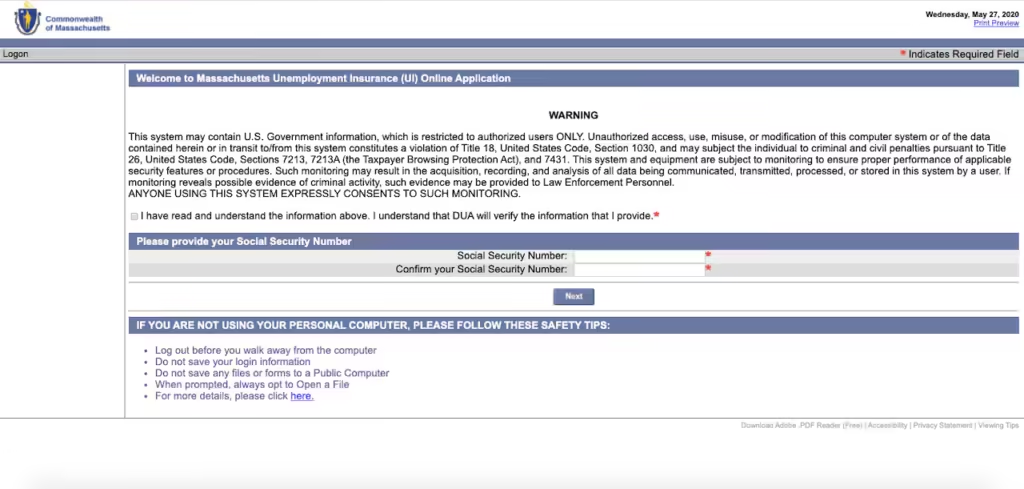Mass unemployment log in, On a cold morning in 2024, John, a software worker, found himself without work for no reason. He was left with a lot of doubt and stress about the future after being fired without warning. As he sat down with his laptop to figure out how to get unemployment benefits, he realised how important it was to know how to join in as a large group of people. This blog post goes into detail about how hard it is to get unemployment benefits during times of mass layoffs. It does this by using relevant statistics, data, and detailed information to help people who are in the same position.
How to Understand mass unemployment log in
What is a lot of unemployment?
Mass unemployment happens when a lot of people lose their jobs all of a sudden. This can happen because of things like economic downturns, changes in technology, or big company reorganisations. It is marked by a sharp rise in the jobless rate, which can have very bad effects on the economy and society.
Historical Background and Current Trends
In the past, events like the Great Depression in the 1930s and the financial crisis of 2008 have caused a lot of people to lose their jobs. Recently, the COVID-19 pandemic caused more job loses than ever before in the world. The International Labour Organisation (ILO) says that the number of unemployed people around the world rose by 33 million in 2020, taking the total to 220 million.
Statistics on mass unemployment
| Year | Global Unemployment Rate (%) | Number of Unemployed (millions) |
|---|---|---|
| 2019 | 5.3 | 187 |
| 2020 | 6.5 | 220 |
| 2021 | 6.2 | 213 |
| 2022 | 5.8 | 198 |
| 2023 | 5.6 | 191 |
What It Means for Different Areas
Different areas are affected by mass unemployment in different ways. One example is that millions of jobs were lost in the tourism and hospitality businesses during the COVID-19 pandemic. On the other hand, industries like technology and healthcare saw less serious effects or even job growth.
How to Use the Unemployment System
Tips on How to Sign In to Get Unemployment Benefits
It can be hard to figure out how to log in for unemployment benefits, especially when there are a lot of people out of work and the systems are busy. Here is a step-by-step guide:
- Get your information ready: Get together all the paperwork you’ll need, like your Social Security number, work history, and bank information for direct payment.
- Make an account: Make an account on the website for your state’s jobless insurance. Make sure you remember your login information and pick a strong password.
- Send in your application: Make sure you correctly fill out the online application form. Include information about your last job, why you’re unemploye, and any severance or leave pay you got.
- Follow-up: Once you’ve sent in your application, make sure you check your account often for changes and requests for more information.
- Claims Every Week: To keep getting benefits, most states make you file claims every week. Sign in once a week to tell what you’ve done to look for work and any money you’ve made.
Common Problems and Ways to Fix Them
Overloaded Systems
When there is a lot of unemployment, a lot of people may visit state websites at once, which can cause them to load slowly or even crash. To lessen this:
- Getting in During Off-Peak Hours: Sign in early in the morning or late at night, when there are fewer people online.
- Use more than one device: If you can’t log in on one computer, try a different one or a different browser.
- Problems: with Documentation
- Benefits may be delayed: if the paperwork is wrong or not full. Make sure that all of the information is correct and up to date.
- Check Information Twice: Before sending, look over all of your entries to make sure they are correct.
- Keep copies: Keep both digital and paper copies of all records you send in.
How technology can be use to handle unemployment claims
Systems and automation that work online
The way jobless claims are handled has change a lot thanks to modern technology. Automated systems make it easier to apply, cut down on mistakes, and speed up the acceptance process. As an example, the Employment Development Department (EDD) of California put in place an automated system that cut working times by 30%.
Privacy and safety of data
As the use of computers online grows, keeping data safe is very important. Cyberattacks are possible because unemployment programs store private information about people, which makes them easy targets. To keep claimant data safe, states need to use strong cybersecurity means like encryption and multi-factor authentication.
Statistics on Technological Improvements
| Year | Average Processing Time (days) | Error Rate (%) |
|---|---|---|
| 2018 | 21 | 5.2 |
| 2019 | 18 | 4.8 |
| 2020 | 25 | 6.3 |
| 2021 | 20 | 5.0 |
| 2022 | 15 | 4.5 |

Effects of High Unemployment on the Economy and Society
Effects on the economy
Mass unemployment hurts the economy in many ways. In turn, this makes people spend less, which hurts companies and can cause a recession. The government has to spend more on social aid programs, which puts a strain on the public purse.
The financial crisis of 2008 as a case study
Massive layoffs and a big rise in jobless rates around the world happened because of the 2008 financial crisis. It reached a high point of 10% in October 2009 in the United States. In response, the government helpe those who hurt by extending jobless benefits and putting together stimulus packages.
Effects on society and mental health
People and groups can be severely affect by unemployment on a social and mental level. Being unemploye for a long time can cause:
Problems with mental health:
- More people are depress and anxious.
- Loss of social ties and support networks is a sign of social isolation.
- Stress in the financial world includes more debt and unstable money situations.
- Help and resources for the community
- People who are struggling with mass unemployment can get important help from their communities. People can deal with problems and get better with the help of resources like job training programs, mental health services, and financial counselling.
Policies and help programs from the government
Insurance for Unemployed People
People who lose their jobs need unemployment insurance more than anything else. It helps people meet their basic needs by giving them short-term cash aid while they look for new work.
Important Things About UI Programs
- Conditions for Eligibility: vary from state to state, but usually mean having worked for a certain amount of time and not being able to find work because of something you did.
- Amount of the benefit: is based on past earnings, up to a certain cap.
- Duration: Usually up to 26 weeks, but during times of high unemployment, increases may be possible.
Deals to Stimulate
During economic downturns, governments often use “stimulus packages” to help people who are hurt and get the economy going again. Direct payments, more unemployment benefits, and money for programs that help people find jobs may all be part of these deals.
COVID-19 Pandemic Relief is an example.
In reaction to the COVID-19 pandemic, the US passed a number of stimulus packages. One of these was the CARES Act, which gave people extra unemployment benefits and direct payments totalling $600 per week.
Programs for retraining and finding work
Retraining and job placement programs are run by governments and non-profits to help people who are jobless learn new skills and find work. During times of rapid technology change, when some jobs may become obsolete, these programs are even more important.
Trade Adjustment Assistance (TAA) is one example.
In the US, the Trade Adjustment Assistance program helps workers who lose their jobs because of competition from other countries by giving them training, job search help, and money to move.
How to Handle Unemployment in the Future
New developments in technology
The future of managing jobless will continue to be shape by changes in technology. New technologies, like artificial intelligence (AI) and blockchain, can make things even easier and safer for data.
AI in Systems for Unemployment
AI can help unemployment programs work better and more accurately by:
- By automating claims handling, processing times and error rates can be cut down.
- Looking at data to guess how unemployment will change over time and make good use of resources.
- Making job suggestions and training plans based on each person’s skills and experience.
New ideas in policy
As work and employment change, governments need to come up with new laws to deal with it. Among these are:
- Universal Basic Income (UBI) means giving all people a guaranteed income, even if they don’t have a job.
- Portable benefits let workers take benefits like health insurance and retirement savings with them to new jobs and job types.
- Making sure that gig workers can get unemployment payments and other social safety nets.
A Look at the World
Different governments have used different methods to deal with unemployment. Looking into these methods can teach us a lot about how to make processes better all over the world.
The Flexicurity Model in Denmark is an example.
The flexicurity approach in Denmark combines strong social protections with flexible job markets. This method offers a lot of job security and help for people who are out of work, with policies like active labour market policies and big unemployment payments.
FAQ about mass unemployment log in:
What do I need to log in to get jobless benefits?
For direct deposit, you will need to know your Social Security number, work background, and bank information.
What should I do if I can’t get to the page for unemployment?
If you’re still having trouble, try going to the site during off-peak hours, using a different device or browser, or calling the unemployment office in your state.
How often do I need to sign in to get my free stuff?
In most states, you have to log in once a week to make claims and report job search activities.
Conclusion
During times of mass unemployment log in, it’s very important to know how to use the complicated mass unemployment log-in processes. We can lessen the effects of mass unemployment log in and build a stronger future by understanding the differences between technical and technological parts of unemployment systems, taking advantage of technological progress, and helping those who are affect by it through comprehensive policies and community resources.


